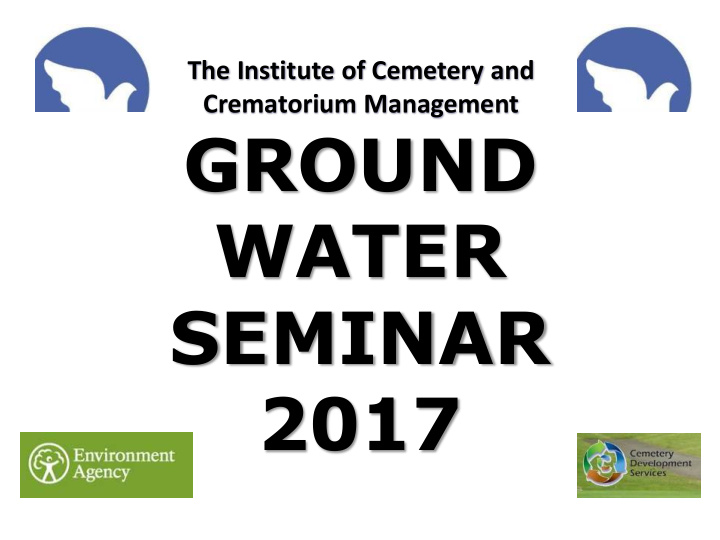



Source Protection Zones SPZs defined around Public Water Supplies and food industry abstractions: Zone I – 50 day travel time to source Zone II – 400 day travel time to source Zone III – total catchment The closer a polluting activity is to a potable groundwater abstraction the greater the risk Maps available on line (WIYBY) Zones are periodically updated
Source Protection Zones
Groundwater Protection Position Statements Sets out our latest framework to make decisions on activities that could impact on groundwater Aims to remove uncertainty and potential inconsistency Overall objective is the prevention of pollution of groundwater and the protection of it as a resource
Latest guidance
March 2017 Guidelines Update and clarification only, nothing ‘new’ Still based on 2004 R&D Technical Report 223 and usual groundwater protection framework Adopts GOV.UK style of writing (non-tech) Live document, so open to ongoing updates Happy to take away queries or suggestions
Locational requirements A burial site must be - outside an Inner Source Protection Zone (SPZ1) at least 250 metres from any potable well, borehole or spring at least 30 metres from any non-potable spring or watercourse at least 10 metres from a field drain or ditch
Grave requirements Graves must – have at least 1 metre clearance between their base and the top of the maximum water table not be dug in areas prone to groundwater flooding be deep enough so at least 1 metre of soil will cover the top of the coffin
General requirements There must be no direct input of hazardous substances to groundwater and no pollution from non-hazardous pollutants (EPR 2010) A site specific risk assessment is required for all proposals, with a Tier 1 as a minimum A site may need some form of intervention to control groundwater levels, e.g., via land raise, drainage or abstraction A site may need groundwater monitoring
Hydrogeological risk assessments
Site conceptual model RECEPTOR e.g. abstraction (or a SOURCE e.g. watercourse) fuel spill PATHWAY = groundwater
Tiered risk assessments Tier 1 – Desk top study and qualitative assessment only (low, medium, high) Tier 2 – Generic quantitative assessment using local / literature data (e.g. soil survey maps, nearby groundwater levels, average rainfall) Tier 3 – Detailed quantitative assessment using largely site specific measurements and bespoke risks modelling
Groundwater monitoring Frequency and extent will depend on – cemetery size and rates of use results of the risk assessment hydrogeological characteristics ongoing results of the monitoring
Typical monitoring requirements One up-gradient, two down-gradient boreholes At least a few metres below the minimum groundwater level 12 months prior, 3 – 5 years post development At Quarterly intervals Possible up- and downstream surface water monitoring too Testing to include pollutants, water conditions, degradation parameters, groundwater level etc
Green burials These usually have more rapid decay rates, as – relatively shallow depth of burial Typically single depth burials biodegradable nature of the coffins / shrouds lack of embalming fluids So pollution risks / planning conditions are much less likely
Existing cemeteries They need to be managed to limit any environmental impacts They can be controlled using our Notice powers if they cause significant and/or ongoing pollution They should have an appropriate risk assessment undertaken…
Many thanks for listening
The Institute of Cemetery and Crematorium Management GROUND WATER SEMINAR 2017
The Institute of Cemetery and Crematorium Management LUNCH
The Institute of Cemetery and Crematorium Management GROUND WATER SEMINAR 2017
Soils, water and risks posed by cemeteries – managing water in cemeteries Alex Vickers & Justin Smith
Physical principles of soil drainage gravity > tension
Physical principles of soil drainage Fine soil Coarse soil Perched water table Tension > gravity
Physical principles of soil drainage Coarse soil Fine soil
What is the cause of poor drainage?
Temporary water tables
High / rising water tables
High water tables
Ultra detailed digital terrain model Groundwater Protection Bore Hole 2 Results Borough Cemetery
Confined aquifer
Effect of depth on drain spacing Dry Dry Wet 0.5m
Effect of depth on drain spacing Dry Dry Dry 1 m
Effect of depth on drain spacing Dry Dry Wet 0.5m
Effect of depth on drain spacing Dry Dry Dry 0.5m
Capillary rise
Capillary rise
Drainage design consideration (laboratory tests)
Capillary rise
Drain spacing and capillary rise
Ochre
Iron ochre
Migration of water from adjacent land
Elevated land
Outfall
Inadequate outfall
Inadequate outfall
Drain survey
Achieving outfall
Recommend
More recommend